The Los Alamos fission yield evaluation pipeline
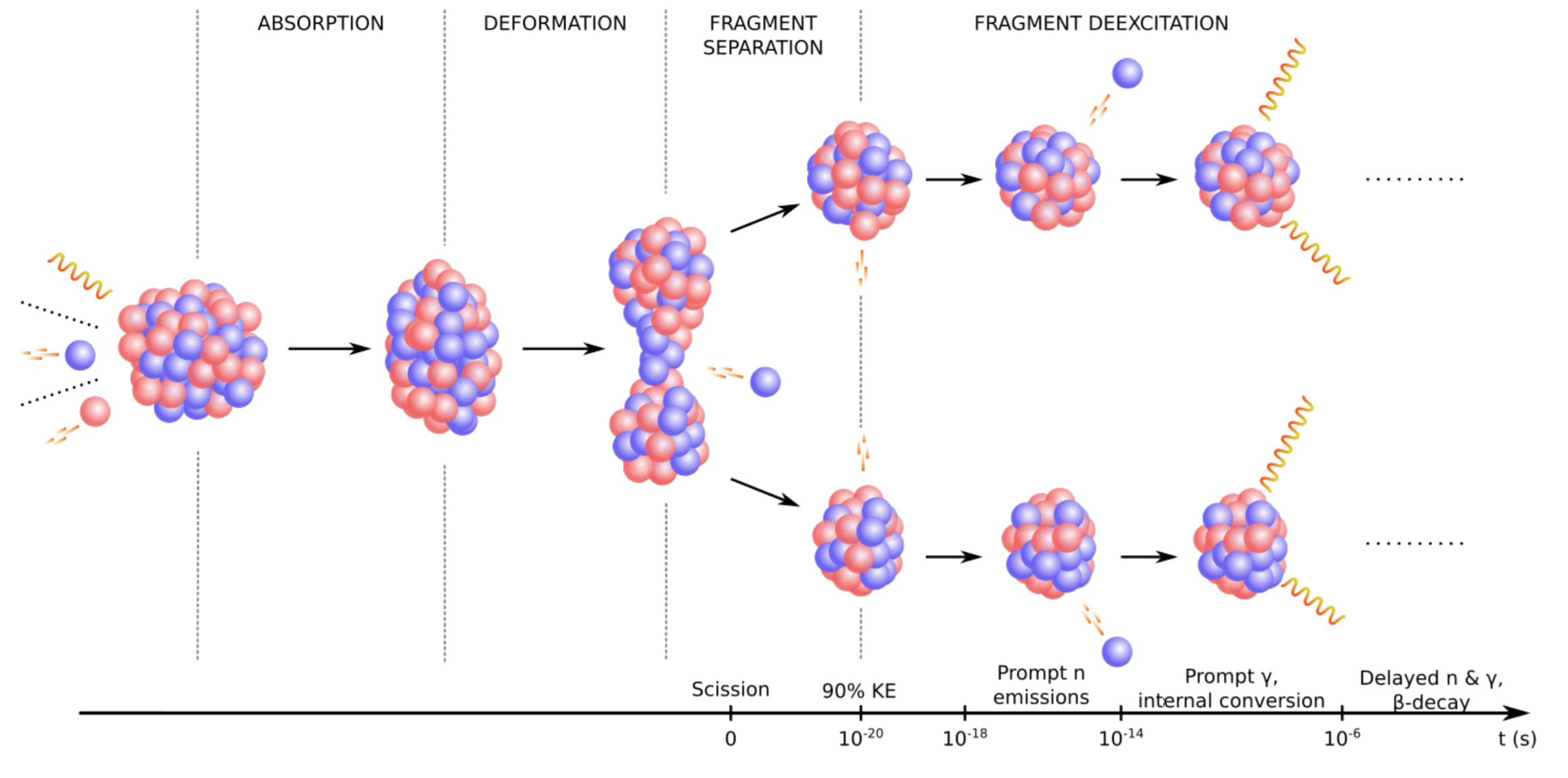

LA-UR-19-29974
Matthew Mumpower
FPY workshop
Thursday Oct. 3$^{rd}$ 2019

Nuclear Data Team
Theoretical Division
Outline
- Motivation
- What is an evaluation?
- Progress on our evaluation pipeline
- Summary

Why do we need fission yields?

Fission yields are needed for a variety of applications
Industrial applications: simulation of reactors, fuel cycles, waste management
Experiments: backgrounds, isotope production with radioactive ion beams (fragmentation)
Science applications: nucleosynthesis, light curve observations
Other Applications: national security, nonproliferation, nuclear forensics
What is a fission yield evaluation?

An evaluation combines experimental and theoretical knowledge consistent with physical laws
to produce a quantity (in this case fission yields) with verifiable quality.
Should be distributed in an easily accessible form that all case use (e.g. ENDF or GNDS)
for a variety of applications
Theory is limited in accuracy & measured data is limited in scope
Current status of fission yield evaluations
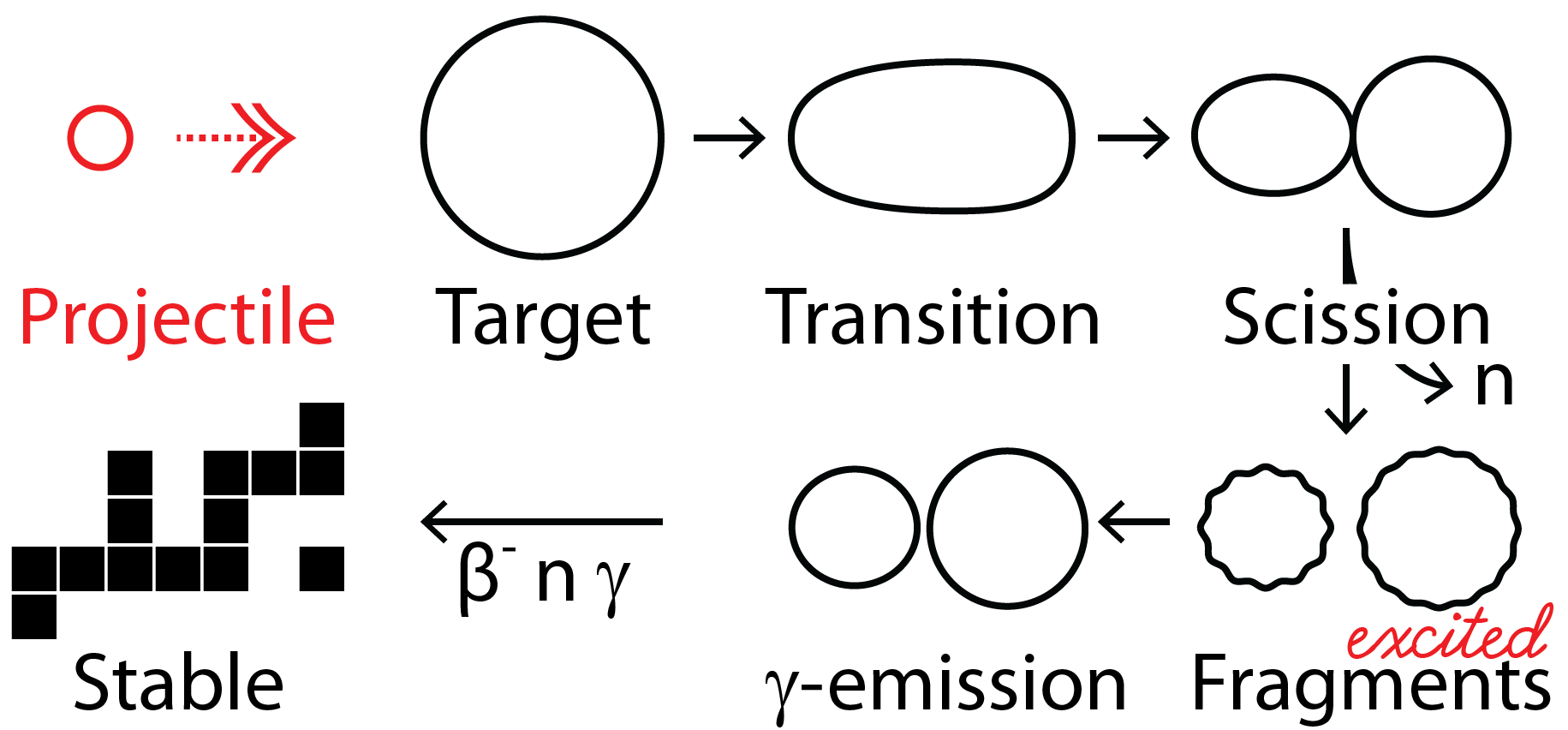
The last update to ENDF fission yield evaluation was in the 1990's
Other evaluations exists such as (JEFF, JENDL, etc.)
We want to improve several key areas:
- improve continuous energy dependent information
- provide consistency between yields, n's & $\gamma$'s and decay data
- more complete uncertainties
The Los Alamos Fission Yield Evaluation
Purpose: to provide a modern evaluation of fission yields
With a focus on consistency between yields, n's & $\gamma$'s, and decay data
This includes:
- independent yield (after prompt particle emission)
- cumulative yield (after all decays)
We also seek to expand continuous energy dependent information
Auxiliary information:
primary yield (before any prompt particle emission)
Particle spectra and multiplicities (n's & $\gamma$'s)
The LANL Fission Evaluation Pipeline
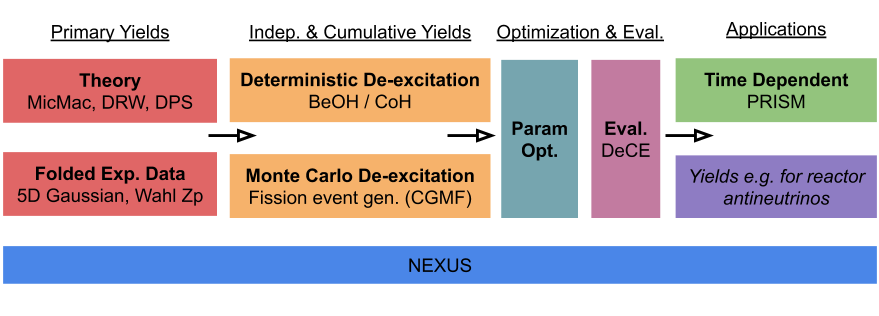
Our current workflow is a combination of many distinct codes
woven together by a Python3 framework called NEXUS.
More Information on LANL Fission Codes
MicMac [C++/Python]: nuclear potential energy surface generation
Theoretical calculation of fissioning system based off Finite-Range Liquid-Drop Model
DRW / DPS [C++/Fortran/Python]: primary yield event generators
Theoretical calculation of fission dynamics based off stochastic random walk
BeOH / CGMF [C++]: de-excitation modeling both deterministically and via Monte Carlo
Follows the statistical decay of excited fragments; IY, CY, isomer ratios
KALMAN [Fortran]: Bayesian parameter optimizer
Linear first-order parameter optimzation scheme
DeCE [C++]: evaluation file interaction
Parsing and generation of evaluation files
PRISM [Fortran/Python]: time-ordered information using nuclear reaction network
Generation of cumulative yield; decay heat
Current capabilities
Theoretical methods for fission
We could try to build our model from the ground up using quantum mechanics - this is hard
Energy-density functional theory (DFT) calculations are built on this approach
Can give key physical insight into system of interest
Drawbacks stem from uncertainty in choice of functionals and high computational costs
Or...
View the nucleus as a liquid drop composed of macroscopic and microscopic terms - less hard
Macroscopic-microscopic methods are based on this approach
Fast and scalable; good for performing global calculations
Drawbacks: these models are not self-consistent; dependent on fine-tuned parameters
A basic picture of fission
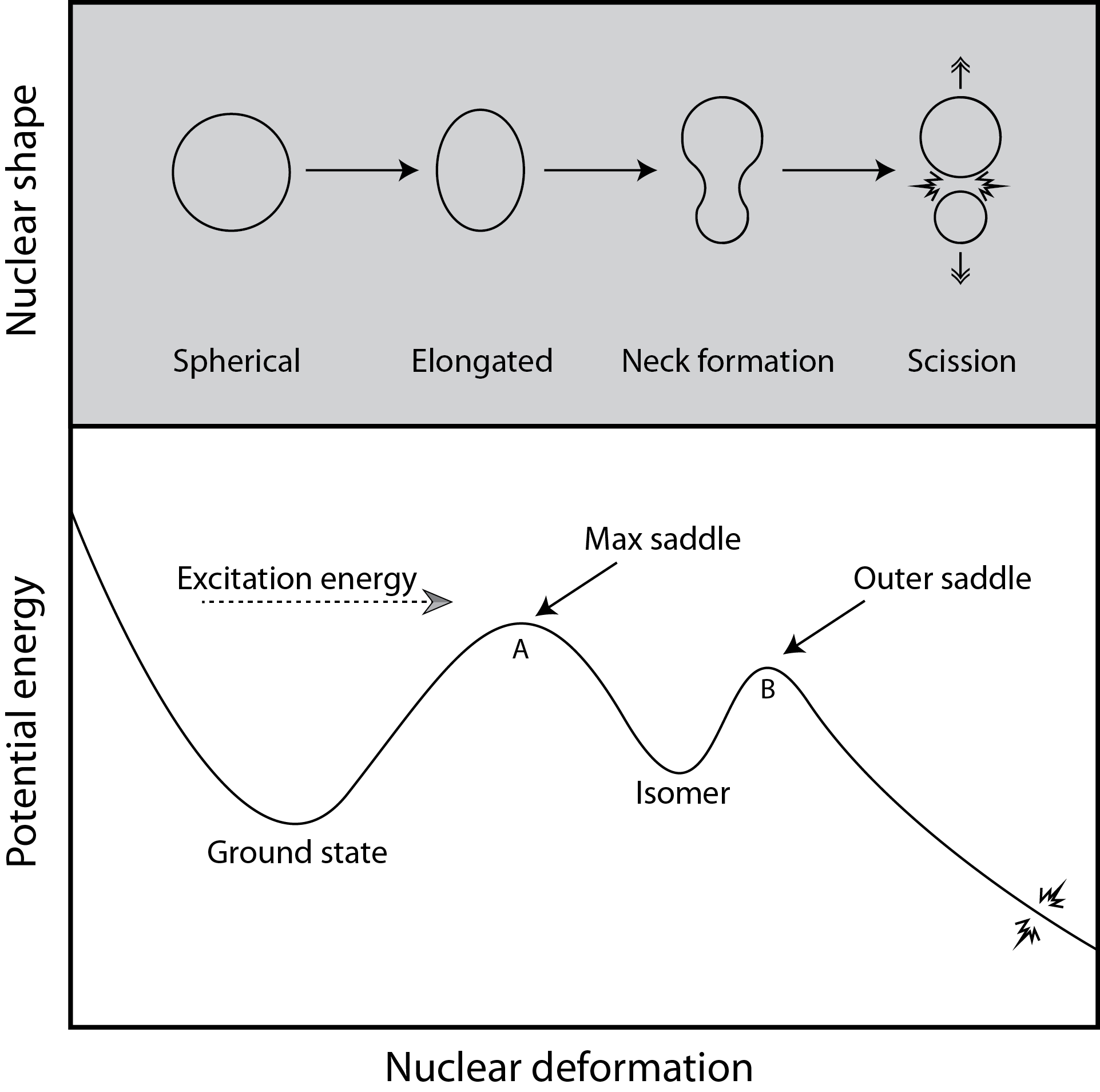
Follow progression of the nucleus from compact to highly elongated shapes
Finite-Range Liquid-Drop Model
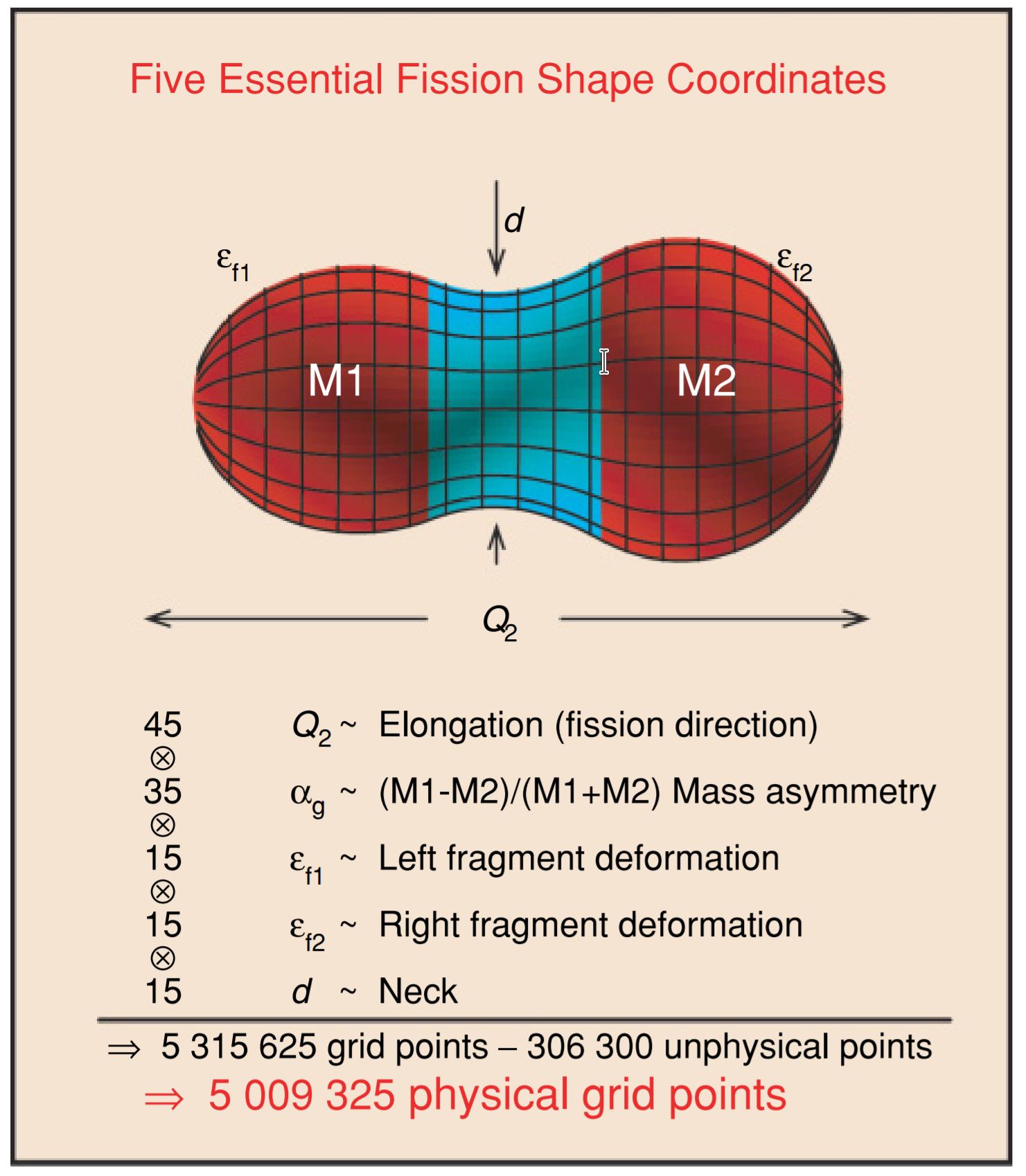
Many possible shape degrees of freedom - but we have to isolate the most important
Calculation of nuclear potential energy surfaces
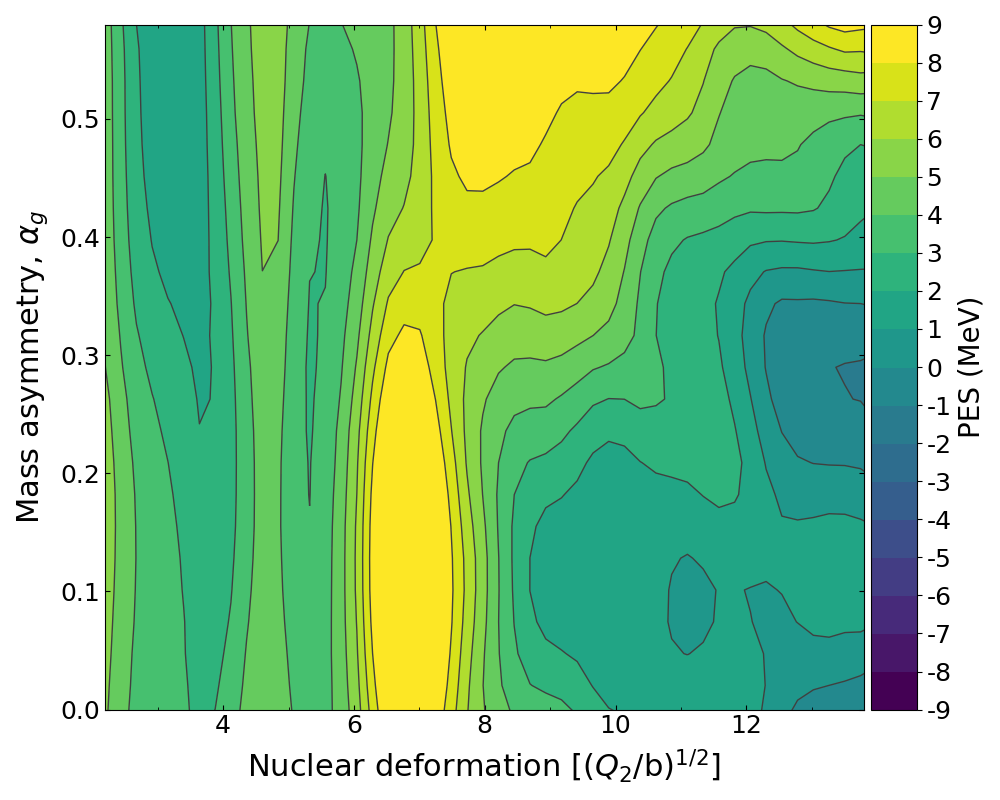
Projected potential energy surface from 5 canonical shape parameters of FRLDM
Path to sission is dependent on the trajectory through this complex surface
Nuclear potential energy surface of 236-U
Calculation of fission yields
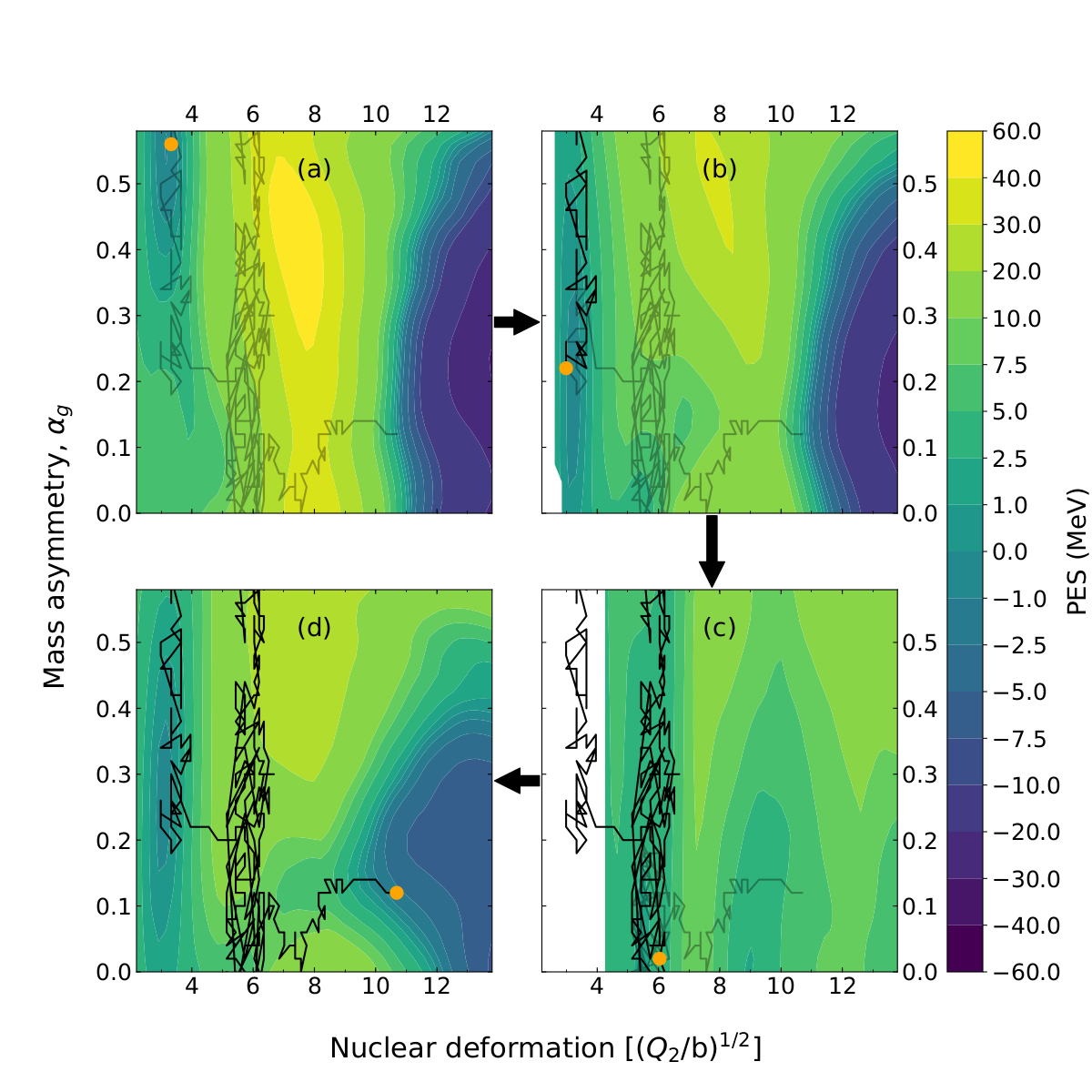
Change in nuclear shape acts as a driving force for bulk rearrangement of material
Amounts to random walk across potential energy surface
Theoretical primary yield compared to data
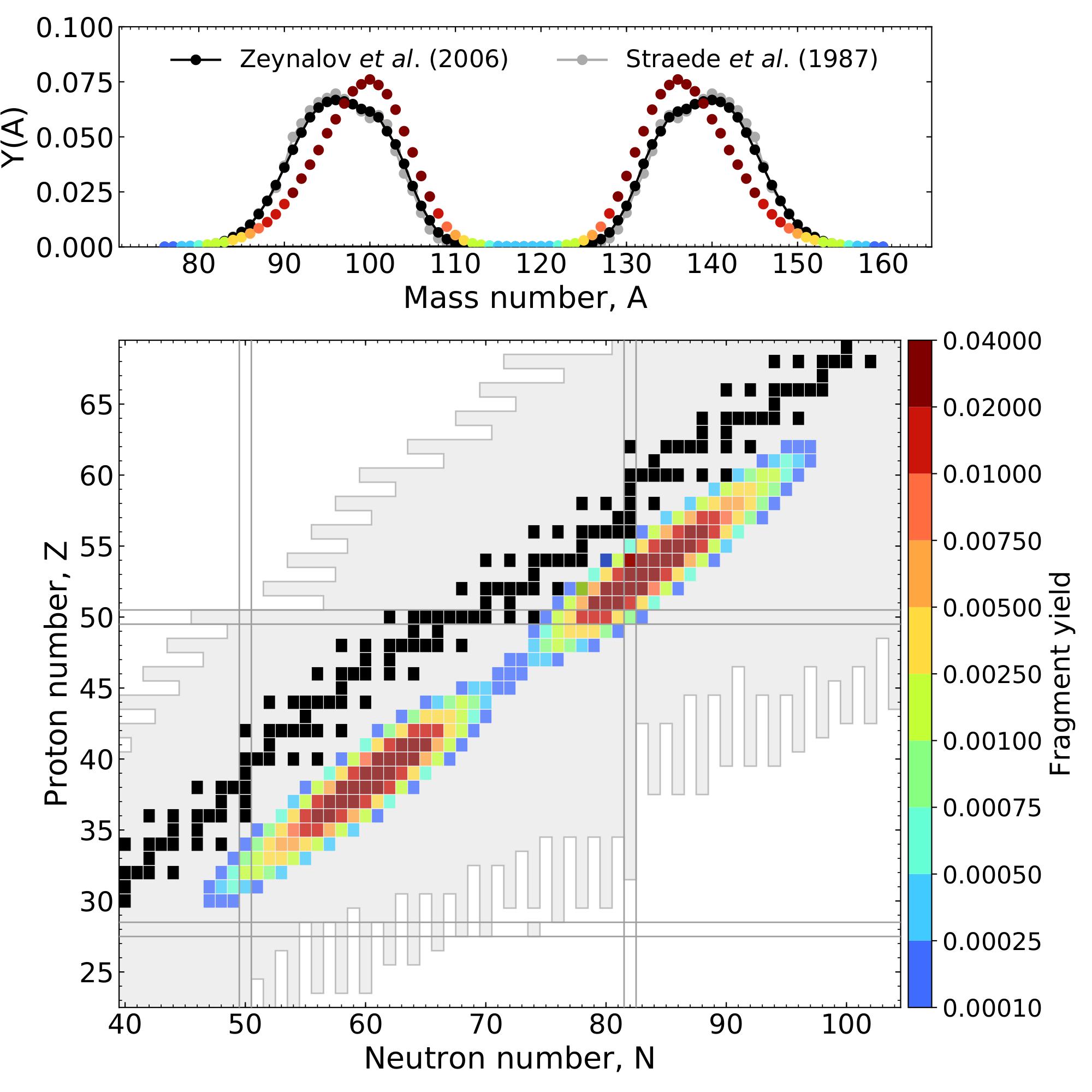
Ensemble of fission events leads to the cumulation of the yield curve ($^{235}$U + n$_{\rm{therm}}$)
Relies on geometric splitting argument for the scission configuration
Charge yield with odd-even staggering
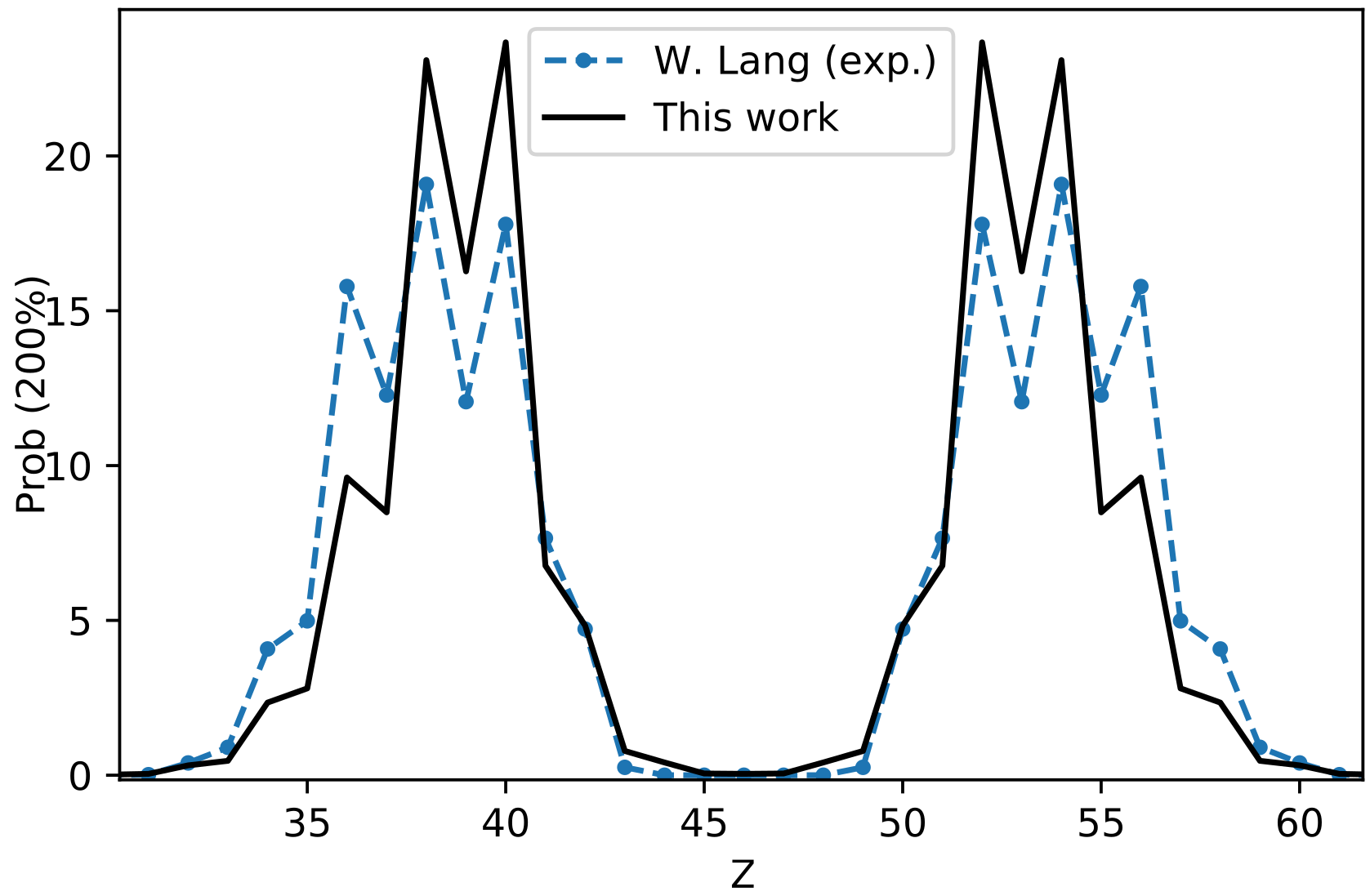
We have further enhanced these calculations; moving beyond the geometric picture
First theoretical prediction of odd-even staggering using a particle number projection technique for $^{235}$U + n$_{\rm{therm}}$
Even more improvement when larger quantum basis is used (recall Marc Verriere's talk)
BeOH: statistical de-excitation
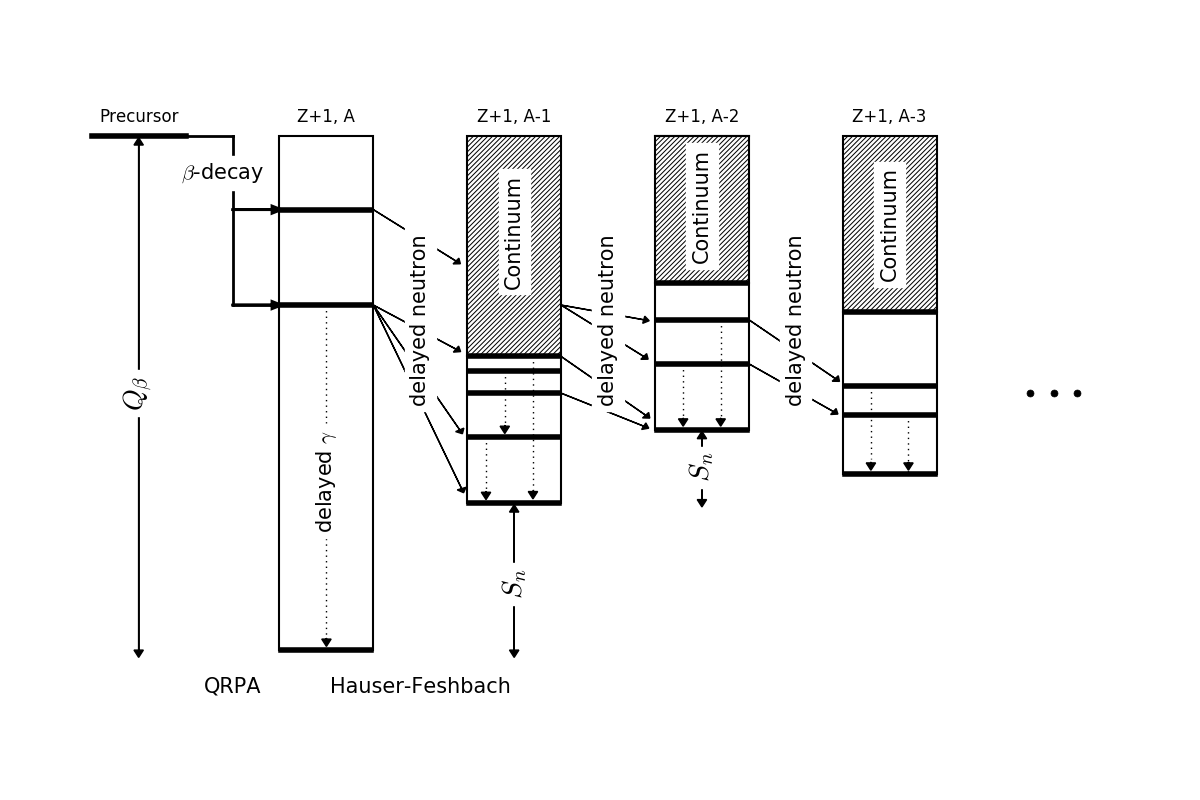
Assume Bohr indepdence hypothesis of compound nucleus formation
Can study n, $\gamma$ and fission competition with $\beta$-decay
Used to study $\beta$-delayed neutron emission and multi-chance $\beta$-delayed fission (new decay mode)
Recently has been applied to statistical de-excitation of nascent fission fragments
Jaffke et al. PRC 97 (2018) • Okumura et al. JNST (2018) • Yokoyama et al. PRC (2019)
Calculation of independent yield
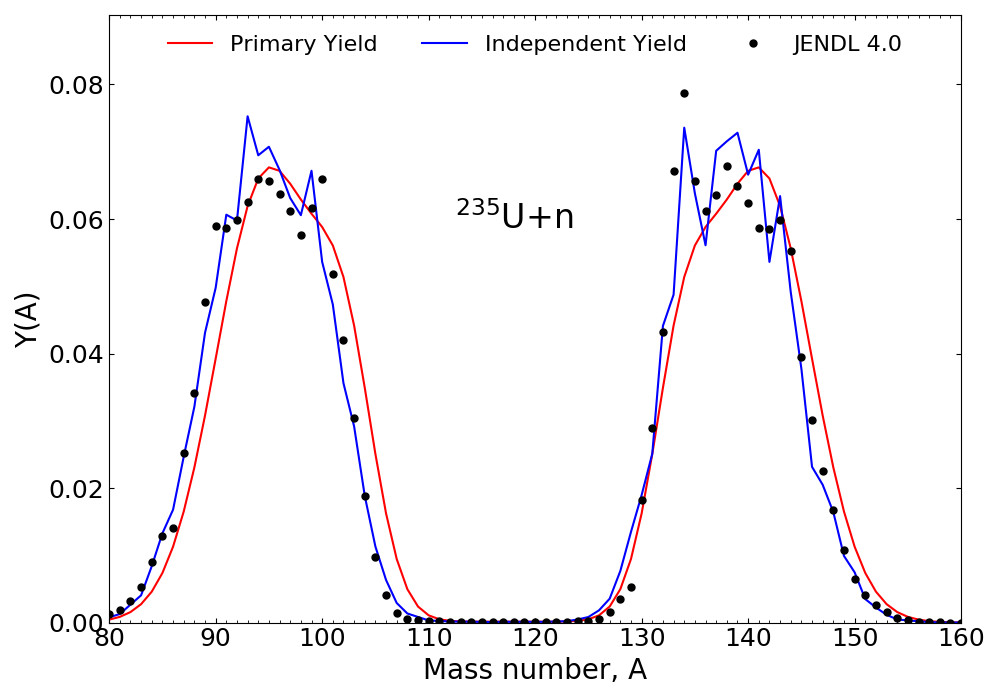
Fit data: Hambsch for $^{235}$U + n thermal fission
Primary yield (PY): using 5D Gaussian fitting procedure; charge systematics from Wahl
Independent yield (IY): after prompt neutron and $\gamma$-ray emission using BeOH / HF$^3$D
Average prompt neutrons

Average prompt neutrons emitted as a function of fragment mass number
Critical inputs: yield; total kinetic energy as a function of mass number and excitation energy sharing
Increasing confidence of using these models for our evaluation efforts
Auxiliary outputs

Consistently calculated with the independent yield
Prompt neutron spectrum; prompt gamma spectrum
Particle multiplicities: P($\nu$), P($N_\gamma$)
Uncertainties & Correlations
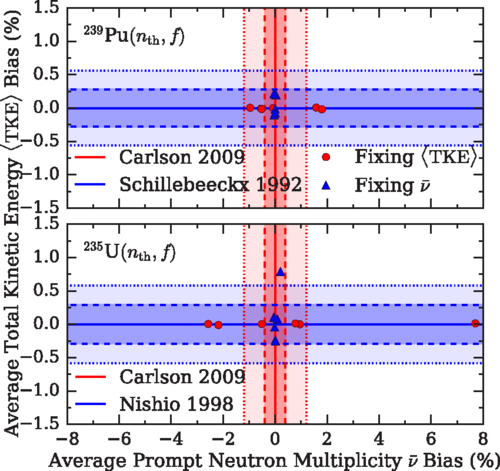
Statistical & systematic uncertainties from experiment
Propagation of parameter uncertainties
Model defects
Special thanks to
The Nuclear Data Team @ LANL
P. Jaffke, T. Kawano, A. Lovell, I. Stetcu, P. Talou, M. Verriere
& many more...
▣ Postdoc ▣ T-2 Staff ▣ XCP-5 Staff
Summary
Current fission evaluations have not been updated in years
and are further lacking for modern applications
An effort to produce an improved fission yield evaluation is underway
We have made major advances in:
Nuclear potential energy surfaces ▴ fission yield calculations ▴ statistical de-excitation
We seek to:
- incorporate new data from recent experiments
- provide consistency between yields, n's & $\gamma$'s, and decay data
- include more continuous energy dependent information
- include time-dependent information (e.g. isomeric ratios)
We are planning to include this new fission yield evaluation in the next ENDF release